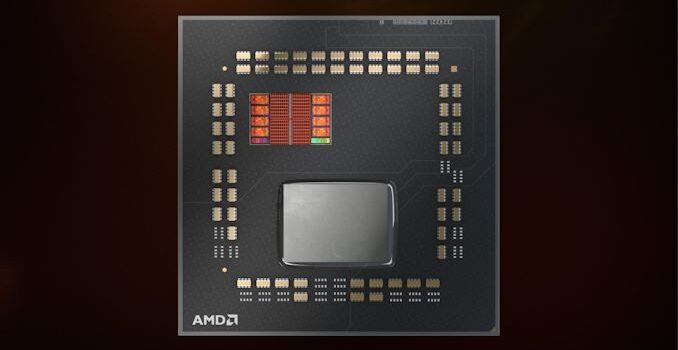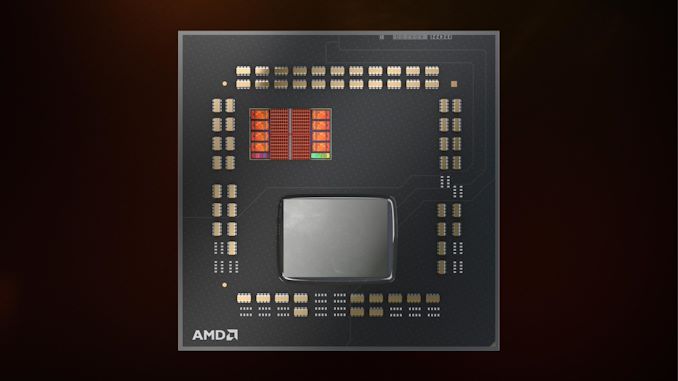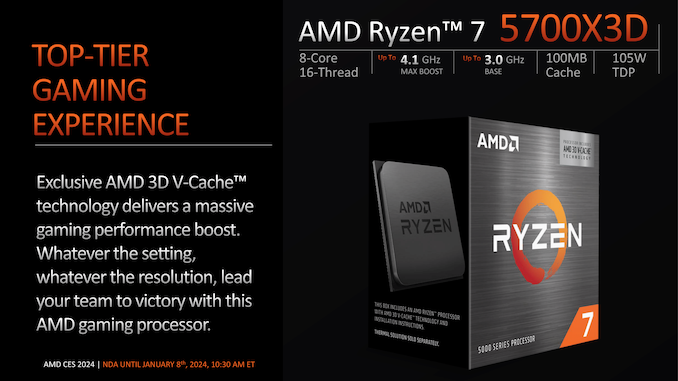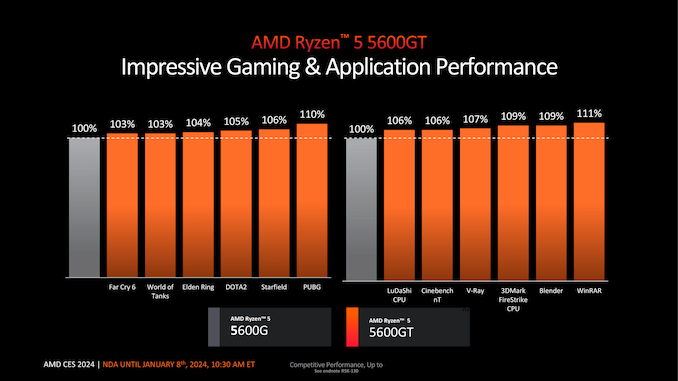AMD Announces New Desktop Zen 3 Chips With 2 New APUs and the Ryzen 7 5700X3D
One of AMD’s most innovative desktop processor designs in recent years has to be the X3D series, with their 3D V-Cache packaging technology. Since AMD launched their Zen 3-based RYzen 7 5800X3D back in April of 2022, the sky has been the limit for AMD’s L3 cache-stacked chips, which have had significant benefits in gaming, especially in titles that can leverage larger amounts of L3 cache. Since the Ryzen 7 5800X3D, AMD launched their latest Ryzen 7000X3D series last year, based on Zen 4, which markedly improved gaming and compute performance. But even more than a year into the release of Zen 4, AMD still isn’t done with Zen 3 and the AM4 platform.
For CES 2024, AMD has launched a third Zen 3 X3D SKU in addition to last year’s limited 6 core Ryzen 5 5600X3D. The latest AMD Ryzen 7 5700X3D offers the same eight Zen 3 cores and sixteen threads (8C/16T) as the original Ryzen 7 5800X3D and with the same large 96 MB pool of 3D V-Cache, but it has lower base and turbo frequencies and an even more affordable price.
And AMD’s AM4 additions aren’t done there. Also announced by AMD at CES 2024 is a new pair of Zen 3-based APUs, which adds to the 5000G(T) line-up. Like the other members of this family, the new SKUs pair up Zen 3 cores with AMD Radeon Vega integrated graphics. The new Ryzen 5 5600GT and Ryzen 5 5500GT both come with a 65 W TDP and faster base and turbo core frequencies compared to the existing Ryzen 5000G series APUs.
Despite being based around the previous Zen 3 microarchitecture, the AM4 desktop platform is still thriving. With new processors to take advantage of the cheaper AM4 boards and DDR4 memory, AMD is looking to leverage the low production costs of their existing (and well amortized) silicon to offer better chips across all budgets.
AMD Ryzen 7 5700X3D: Even Cheaper 8C/16T Zen 3 X3D
With AMD over a year into the Zen 4 architecture, many would expect their focus to be on further Zen 4 chips. And while AMD has a diverse portfolio of processors, architectures, platforms, and products, the continued sales of AM4 hardware and their low costs make it easy to see why AMD has added another Zen 3-based chip with 3D V-Cache to the market.
Enter the AMD Ryzen 7 5700X3D, an alternative to the very popular Ryzen 7 5800X3D, which broke the mold on typical desktop processors through AMD’s 3D V-Cache packaging technology. Coming with 96 MB of 3D packaged L3 V-cache in total (32 MB + 64 MB), all of this is accessible on a single CCD with 8C/16T, with Zen 3 cores, the same as the 5800X3D.
| AMD Ryzen 7000/5000 X3D Chips with 3D V-Cache | ||||||||
| AnandTech | Cores Threads |
Base Freq |
Turbo Freq |
Memory Support |
L3 Cache |
TDP | PPT | Price ($) |
| Ryzen 9 7950X3D | 16C / 32T | 4.2 GHz | 5.7 GHz | DDR5-5200 | 128 MB | 120W | 162W | $650 |
| Ryzen 9 7900X3D | 12C / 24T | 4.4 GHz | 5.6 GHz | DDR5-5200 | 128 MB | 120W | 162W | $499 |
| Ryzen 7 | ||||||||
| Ryzen 7 7800X3D | 8C / 16T | 4.2 GHz | 5.0 GHz | DDR5-5200 | 96 MB | 120W | 162W | $399 |
| Ryzen 7 5800X3D | 8C / 16T | 3.4 GHz | 4.5 GHz | DDR4-3200 | 96 MB | 105W | 142W | $359 |
| Ryzen 7 5700X3D | 8C / 16T | 3.0 GHz | 4.1 GHz | DDR4-3200 | 96 MB | 105W | 142W | $249 |
| Ryzen 5 | ||||||||
| Ryzen 5 5600X3D | 6C /12T | 3.3 GHz | 4.4 GHz | DDR4-3200 | 96 MB | 105W | 142W | $230 |
Although the general specifications of the latest Ryzen 7 5700X3D are nearly identical to the Ryzen 7 5800X3D, there are a few notable differences to highlight. The Ryzen 7 5700X3D has a 400 MHz lower base core clock speed, which sits at 3.0 GHz. Keeping with core frequencies, the turbo frequency on the Ryzen 7 5700X3D is also 400 MHz lower than the 5800X3D (4.1 vs. 4.3 GHz), although both chips share the same 105 W base TPD, with a 142 W Package Power Tracking (PPT) rating; this is how much power is fed through the AM4 CPU socket. All of AMD’s Ryzen 5000X3D processors support DDR4-3200 memory and are CPU ratio/frequency locked, meaning users can’t overclock them.
What sets the Ryzen 7 5700X3D and Ryzen 7 5800X3D processors apart, aside from core frequencies, is the price, with AMD setting an MSRP of $249 for the 5700X3D. In contrast, the Ryzen 7 5800X3D is currently available to buy at Amazon for $359, so for a reduction of 400 MHz across the board, users can have a similar chip, albeit slower, for around $110 less. Given that the target market for these processors is gamers, any CPU-saving can be put towards a discrete graphics card, with graphics being a much more ideal component to upgrade for faster and higher average frame rates than the CPU or memory.
AMD Ryzen 5 5600GT & 5500GT: Zen 3 APUs with Faster Core Frequencies
Also announced for AMD’s previous AM4 platform is a pair of new APUs, which adds to the already established Ryzen 5000G series of processors. Under the new “GT” moniker, the AMD Ryzen 5 5600GT and 5500GT slot in alongside the existing Ryzen 5 5600G and 5600GE APUs, which are both based on AMD’s Cezanne Zen 3 silicon and paved the way for the new Zen 4 APUs which AMD also announced during CES 2024.
| AMD Ryzen 5000G/GT Series APUs (Zen 3) | |||||||
| AnandTech | Core / Thread |
Base Freq |
Turbo Freq |
GPU CUs |
GPU Freq |
PCIe * |
TDP |
| Ryzen 7 | |||||||
| Ryzen 7 5700G | 8 / 16 | 3800 | 4600 | 8 | 2000 | 16+4+4 | 65 W |
| Ryzen 7 5700GE | 8 / 16 | 3200 | 4600 | 8 | 2000 | 16+4+4 | 35 W |
| Ryzen 5 | |||||||
| Ryzen 5 5600G | 6 / 12 | 3900 | 4400 | 7 | 1900 | 16+4+4 | 65 W |
| Ryzen 5 5600GE | 6 / 12 | 3400 | 4400 | 7 | 1900 | 16+4+4 | 35 W |
| Ryzen 5 5600GT | 6 / 12 | 3600 | 4600 | 7 | ? | 16+4+4 | 65 W |
| Ryzen 5 5500GT | 6 / 12 | 3600 | 4400 | 7 | ? | 16+4+4 | 65 W |
| Ryzen 3 | |||||||
| Ryzen 3 5300G | 4 / 8 | 4000 | 4200 | 6 | 1700 | 16+4+4 | 65 W |
| Ryzen 3 5300GE | 4 / 8 | 3600 | 4200 | 6 | 1700 | 16+4+4 | 35 W |
| *PCIe lanes on the SoC are listed in 16xGFX + 4xChipset + 4 for NVMe | |||||||
Looking at what separates the new GT series from the original G line-up, both the Ryzen 5 5600GT and Ryzen 5 5500GT have similar specs to the 5600G/GE chips, with the same Radeon Vega 7 integrated graphics. This is a testament to the Vega GPU architecture’s longevity, and also makes for a bit of an awkward moment as AMD is in the process of winding down driver support for it.
With regards to specs, the Ryzen 5 5600GT has a 300 MHz slower base frequency than the Ryzen 5 5600G but has a 200 MHz faster turbo core clock speed, which tops out at 4.6 GHz. The Ryzen 5 5500GT also has the same 3.6 GHz base frequency as the 5600GT but shares the same 4.4 GHz turbo frequency as the 5600G.
At the time of writing, AMD hasn’t provided us with the graphics core frequencies on the Radeon Vega 7 integrated graphics, but we would expect them to be similar to the 1.9 GHz on the Ryzen 5 5600G/GE processors. It’s also worth noting that the Ryzen 5 5600GT and 5500GT have a 65 W base frequency, with the same 6C/12T of Zen 3 cores.
AMD has provided some basic performance metrics from their in-house testing for the Ryzen 5 5600GT, which compares it directly to the previous Ryzen 5600G. With faster turbo clock speeds, AMD shows that the Ryzen 5600GT performs around 5% in DOTA 2 and 10% better in PUBG, while compute performance in applications such as Blender show gains of 9% and 11% in WinRAR. AMD also outlines that the Ryzen 5 5500GT also performs better in applications such as CineBench nT by around 2% compared to the 5600G and marginally better gaming performance (1% better) in World of Tanks and Mount & Blade 2.
As they are the same silicon as the other Ryzen 5000 series APUs, both the Ryzen 5 5600GT and 5500G include 16 x PCIe 3.0 lanes for a discrete graphics card should users wish to upgrade, as well as 4 x PCIe 3.0 lanes interlinking the chip to the chipset and 4 x PCIe 3.0 lanes designated for an M.2 storage drive. None of which is very fast in 2024, but it is quite cheap. On which note, it’s also worth noting that AMD is bundling their Wraith Stealth cooler with both processors, which saves users money, as an additional CPU cooler purchase isn’t required.
The AMD Ryzen 7 5700X3D is expected to cost $249, while the Ryzen 5 5600GT and Ryzen 5 5500GT will retail for $140 and $125, respectively. All three of AMD’s new Zen 3-based processors will be available to buy from January 31st from all major retailers.
Source: Recent News




